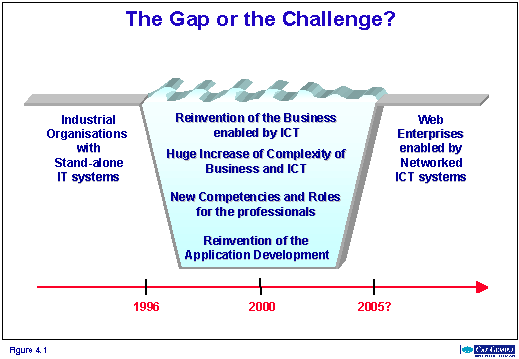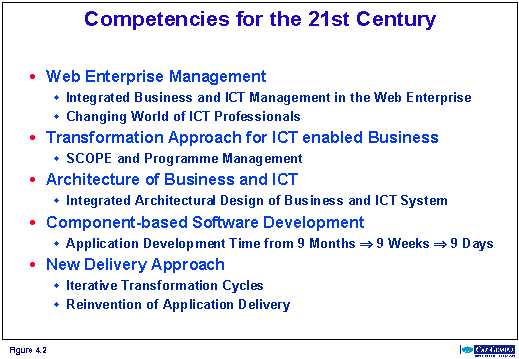Outline of ProgrammeX
| 4. Competencies for the 21st Century |

The transition from industrial organisations and stand-alone IT systems to the new virtual, agile and adaptive Web Enterprises enabled by ICT causes a big gap or to take a more positive perspective an exciting challenge for the designers and developers of both these new businesses and the supporting ICT systems.
The transition of the gap and the changing business concepts are the main challenges for ICT suppliers like Cap Gemini in the next years. Cap Gemini must develop the knowledge, methods and skills or in one word new competencies.
These competencies will:
- Support our customers in the reinvention of their business enabled by ICT and in creating the new Web Enterprises.
- Manage the huge increase of complexity of the new Web Enterprises and of the world-wide network of corporate and private ICT systems connected by the Internet.
- Support our business and ICT professionals in their newly emerging roles in the realisation of ICT enabled Web Enterprises.
- Realise a reinvention of the application delivery resulting in faster development of more complex information systems.
This chapter provides an overview of these competencies.
4.2 The Competencies

Cap Gemini is developing the competencies that the company needs to meet the challenges of the 21st Century. In this Outline of ProgrammeX we focus on competencies in the following areas:
- Web Enterprise Management
- Transformation approach for ICT enabled business
- Architectural design of business and ICT System
- Component-based software development
- New delivery approach for business and ICT transformation
The development of these competencies is especially aimed to meet the ICT challenges and to support the realisation the ICT enabled Web Enterprises.
The approach for ICT enabled business transformation is already developed within Cap Gemini. The objective of Programme X is to develop new competencies for the Web Enterprise management, architecture, component-based development and the transformation delivery.
These competencies must enable Cap Gemini to realise with its customers the ICT enabled business of the next century.
4.2.1 Web Enterprise Management
ICT will have a pervasive and ubiquitous character in the Web Enterprise. The management of ICT resources and services must become an integral part of the business management of the Web Enterprise. Chapter 5 describes some aspects of this new Web Enterprise Management. These include:
- The need for a new management approach in the Web Enterprise
- The main areas of Web Enterprise Management: business management and ICT management
- The changing world of the ICT professionals. The ICT organisations within companies are developing from production-oriented through a service-oriented stage to a business-oriented focusing on the roles of ICT in the business of the Web Enterprise. ICT providers follow a same shift from product-oriented via service-oriented to business-oriented and will focus on the business benefits of their services and products. ICT organisations and ICT providers will eventually also work together in an ICT Web Enterprise aimed at the delivery of ICT services to companies in a business Web Enterprise. This development will change the roles of ICT professionals and also the human resource management of professionals.
4.2.2 Transformation Approach for ICT enabled Business
Cap Gemini has developed an approach for the transformation of business and ICT. The approach supports complex changes of business and ICT in two ways:
- A solution definition (or SCOPE)
Before starting the transformation a team of employees of the customer and professionals of Cap Gemini define an agreed solution for the transformation. The definition consists of a vision and a global design of the result of the transformation of business and ICT. A business case describes the expected business benefits of the transformation. The solution definition also contains a plan of the transformation in the form of a global transformation programme of delivery projects.- Programme Management
Programme Management is the method for managing the transformation programme of delivery projects realising a large transformation of business and ICT that aims at the realisation of the business benefits defined in the agreed solution.The Transformation Approach of Business and ICT supports:
- Business benefits are leading
The solution of the transformation is primarily expressed in the expected business benefits and not in a changed business process or a new information system. During the transformation both the solution and the programme are adapted when the expected business benefits are not achieved.- Continuous alignment between business and ICT and adoption of new technology
The solution definition is aimed to deliver a solution that aligns the business vision of the company with a vision on the role of ICT in the business. Important in this vision is the role of technology as enabler of new business. The transformation programme supports a gradual transformation of business and ICT. The programme is flexible and the content and sequence of development projects is adaptable to changes in the business requirements and the available technology.4.2.3 Architecture
Cap Gemini is developing an architecture, that supports a coherent design and realisation of ICT enabled business. This guarantees the full integration between the human organisation of the business and electronic functionality of the ICT system.
Cap Gemini sees architecture as a set of principles expressed in rules and guidelines that support our architects in the design of the business and ICT system that will result from a transformation.
The architecture integrates four architecture main areas: business, information, information system and technology infrastructure. The architecture also focuses on the design of special aspects such as security and governance.
The Cap Gemini Architecture supports:
- Business and ICT alignment.
Most ICT architectures focus on the design of the infrastructure and the software of the ICT system. The Cap Gemini architecture focuses also the design of the business and especially the business information. The result is a business and ICT solution with a perfect alignment between the business and the ICT system.- ICT enabled Web Enterprises
Programme X will develop the Actor-based Architectural Design approach for the design of the business and ICT system of the ICT enabled Web Enterprise. The architecture is aimed at the new virtual, agile and adaptive organisation of both the business and the applications of the ICT system. There is a shift in focus from information to communication and co-operation within the business. Special attention is paid to knowledge exchange and knowledge creation.
Information system and technology architecture are based on the concept of a world-wide ICT infrastructure which supports Web Enterprises with participating companies and individuals all over the globe.4.2.4 Component-based Software Development
Cap Gemini is developing a component-based approach for the application development. The method is not based on the reuse of small application "parts" but of components on the level of more complex sub-assemblies, like an application supporting all transactions for a bank account.
The Component Based Development (CBD) of applications supports:
- Faster Application Delivery
Cap Gemini wants to reduce a current development period for an application of nine months to nine weeks or even to nine days. CBD is the way to realise this faster application development.- Alignment between Business and ICT and Adoption of New Technology
CBD makes a distinction between business components and ICT specific components. This clearly separates business-specific functionality from technology-specific functionality. New business applications make use of existing technology components. New technology is made available for business applications through new or adapted technology-specific components.- Reliability of Complex Distributed Systems
CBD solves an important contradiction in the feasibility of applications:
How can I build an application that is both complex and adaptable while still being reliable?- ICT enabled Web Enterprise
Without CBD the ICT enabled Web Enterprise is difficult and perhaps impossible to realise. We have advanced ideas about the business of the Web Enterprise. Within a few years the hardware is certainly not longer a barrier. The only problem is how to develop the software that meets the requirements of the Web Enterprise in a reasonable period of time. CBD will contribute to the solution of this problem.4.2.5 Delivery Approach
The Architecture and Component-based Development will strongly influence the way in which a business and ICT transformation is delivered. Chapter 9 gives an overview of the most important changes. These include:
- An iterative delivery approach: The whole complexity of the ICT enabled Web Enterprise is not realised in one Big Bang but gradually and evolutionary over a period of many years.
- Delta Analysis: New ICT applications are not designed and developed from scratch but as an extension and modification of existing components and frameworks.
- Transition of Existing Systems
- Reinvention of the Application Delivery: from craft to mass-customisation.